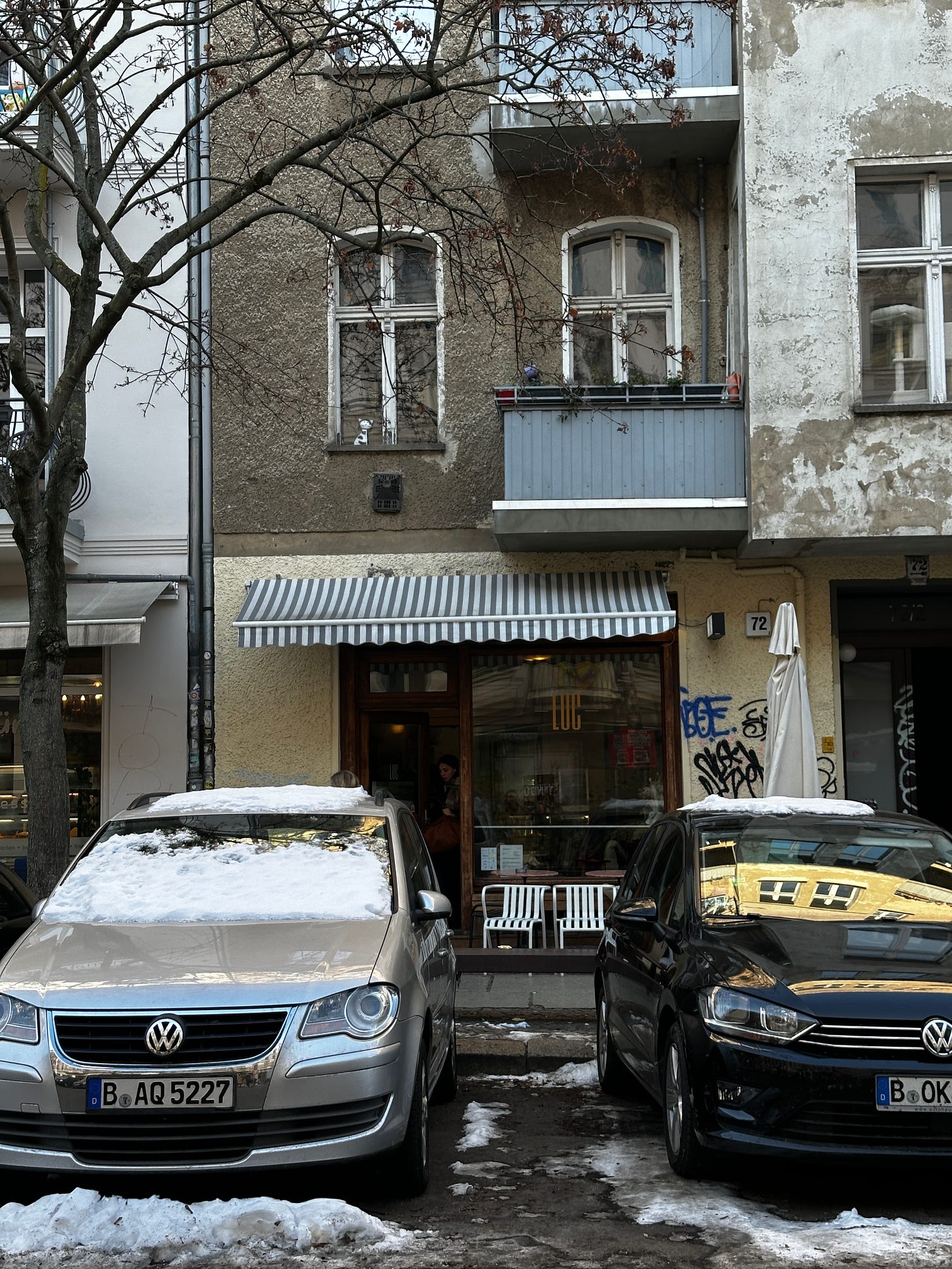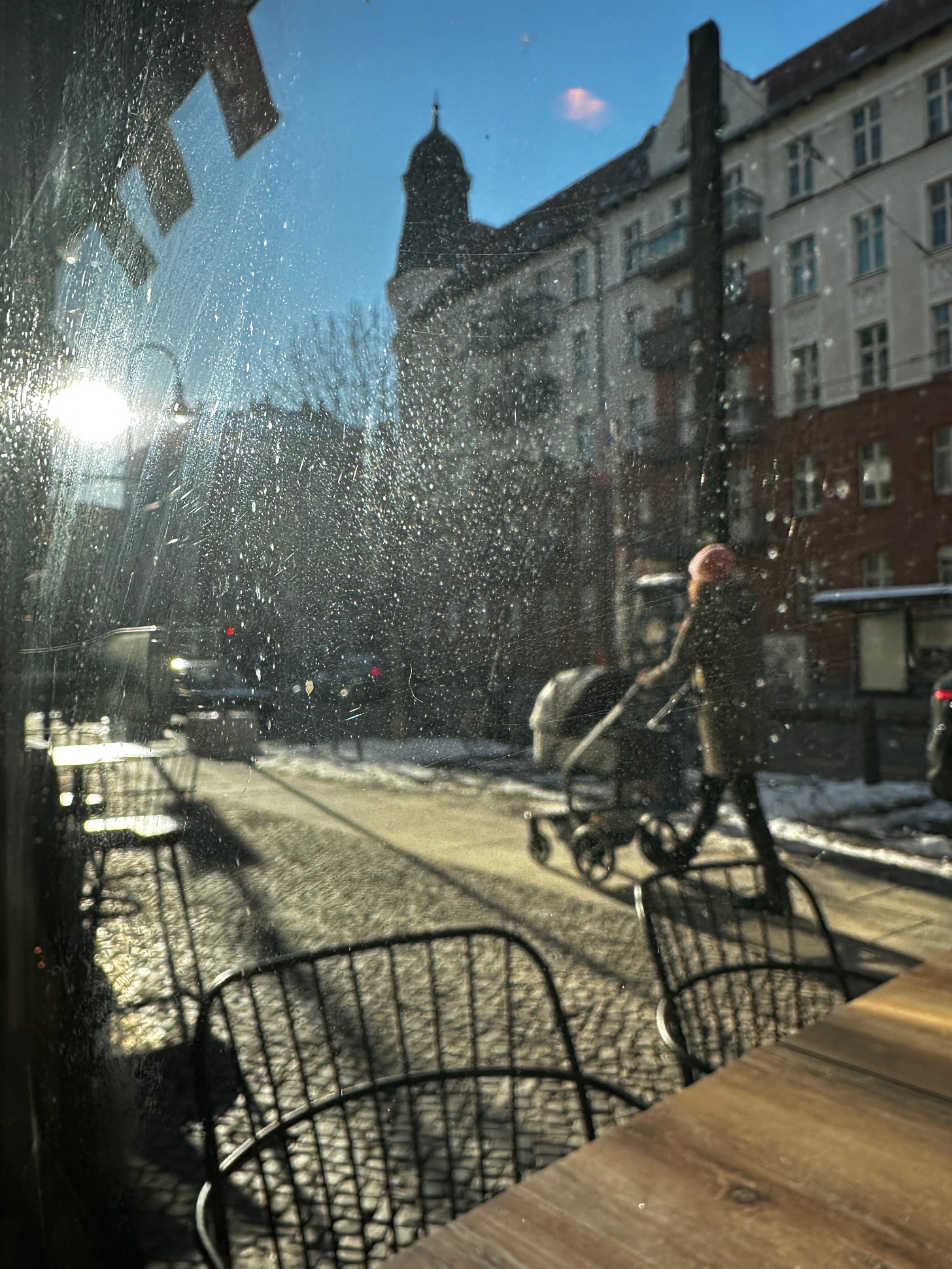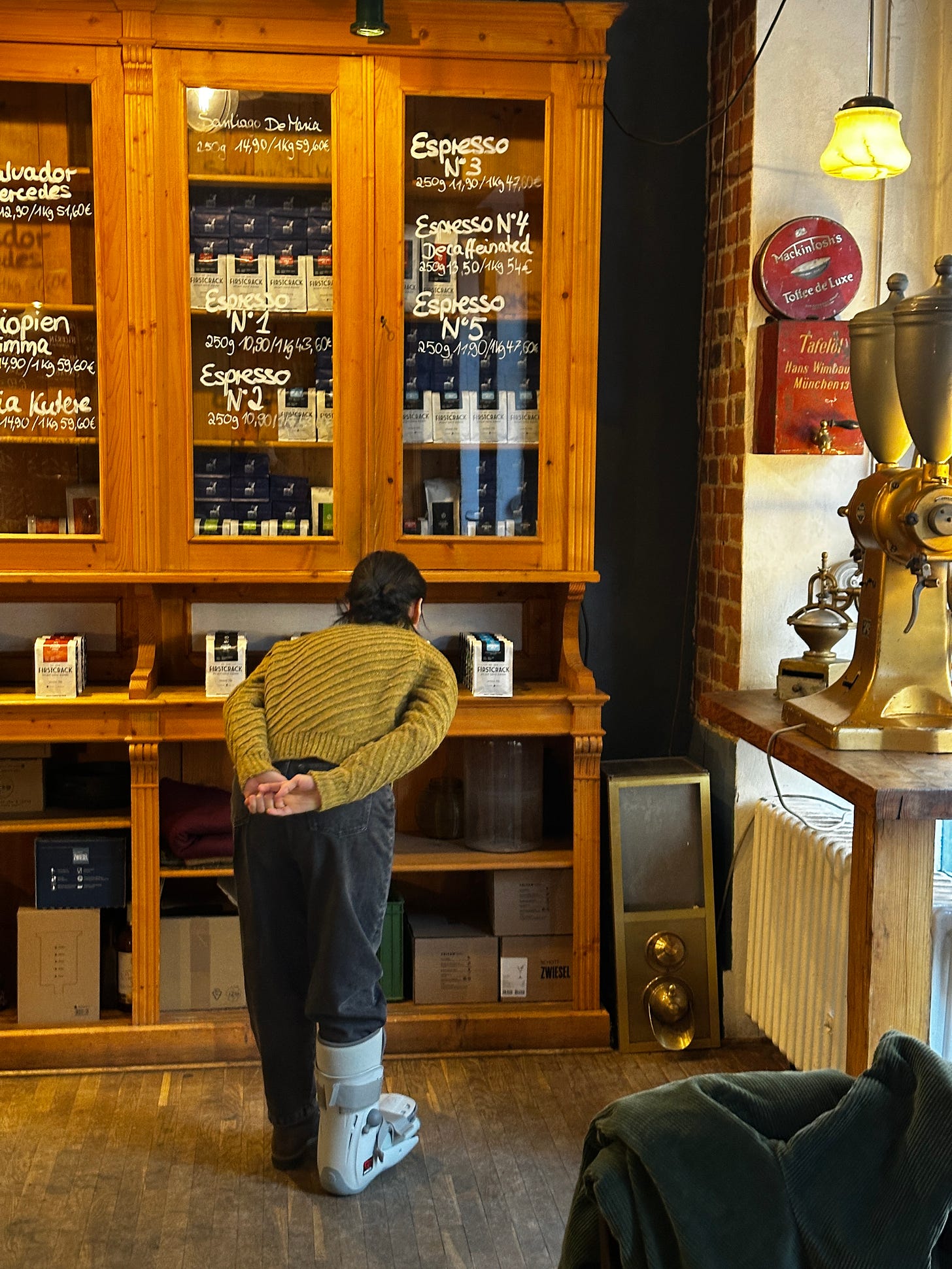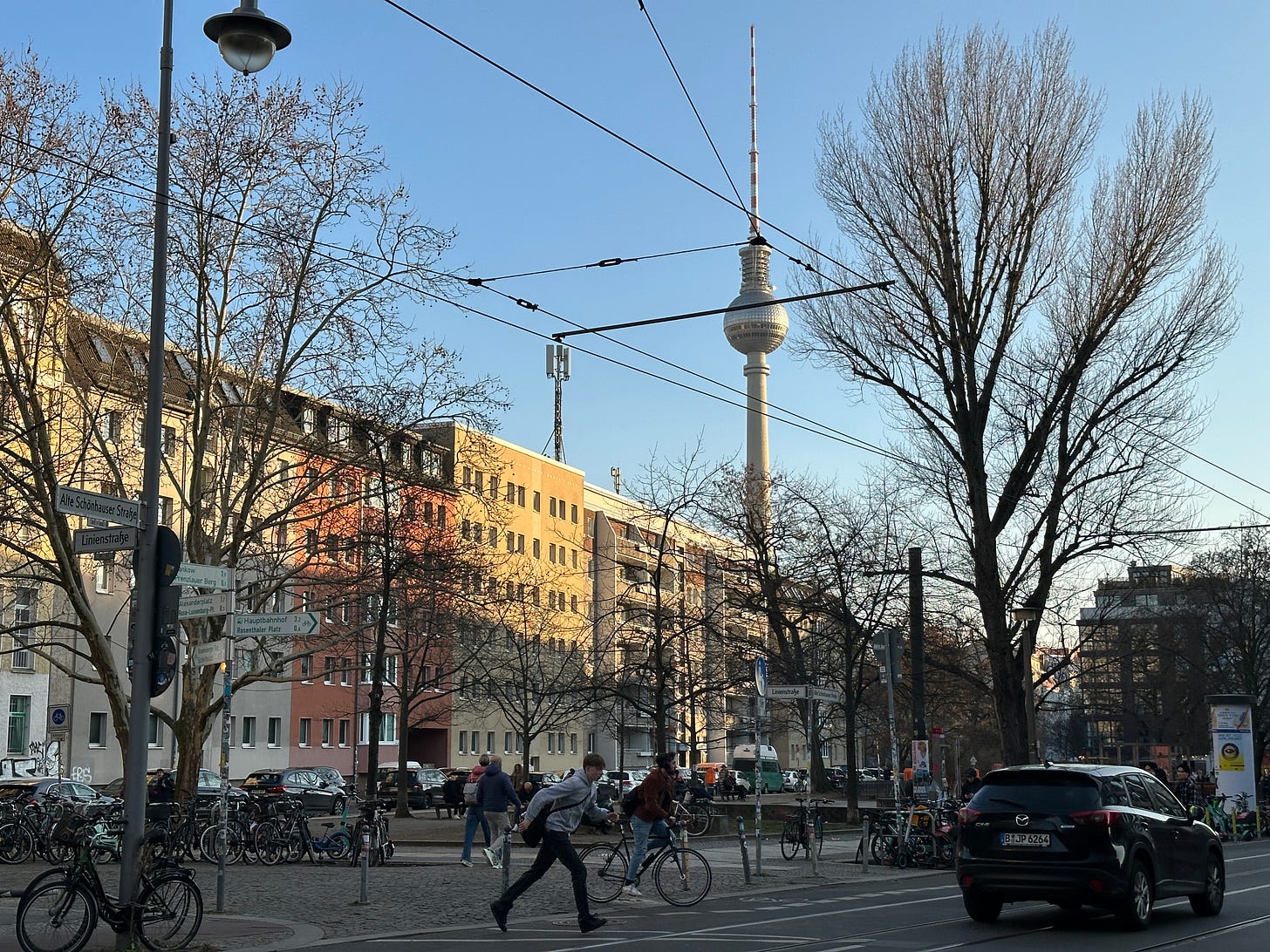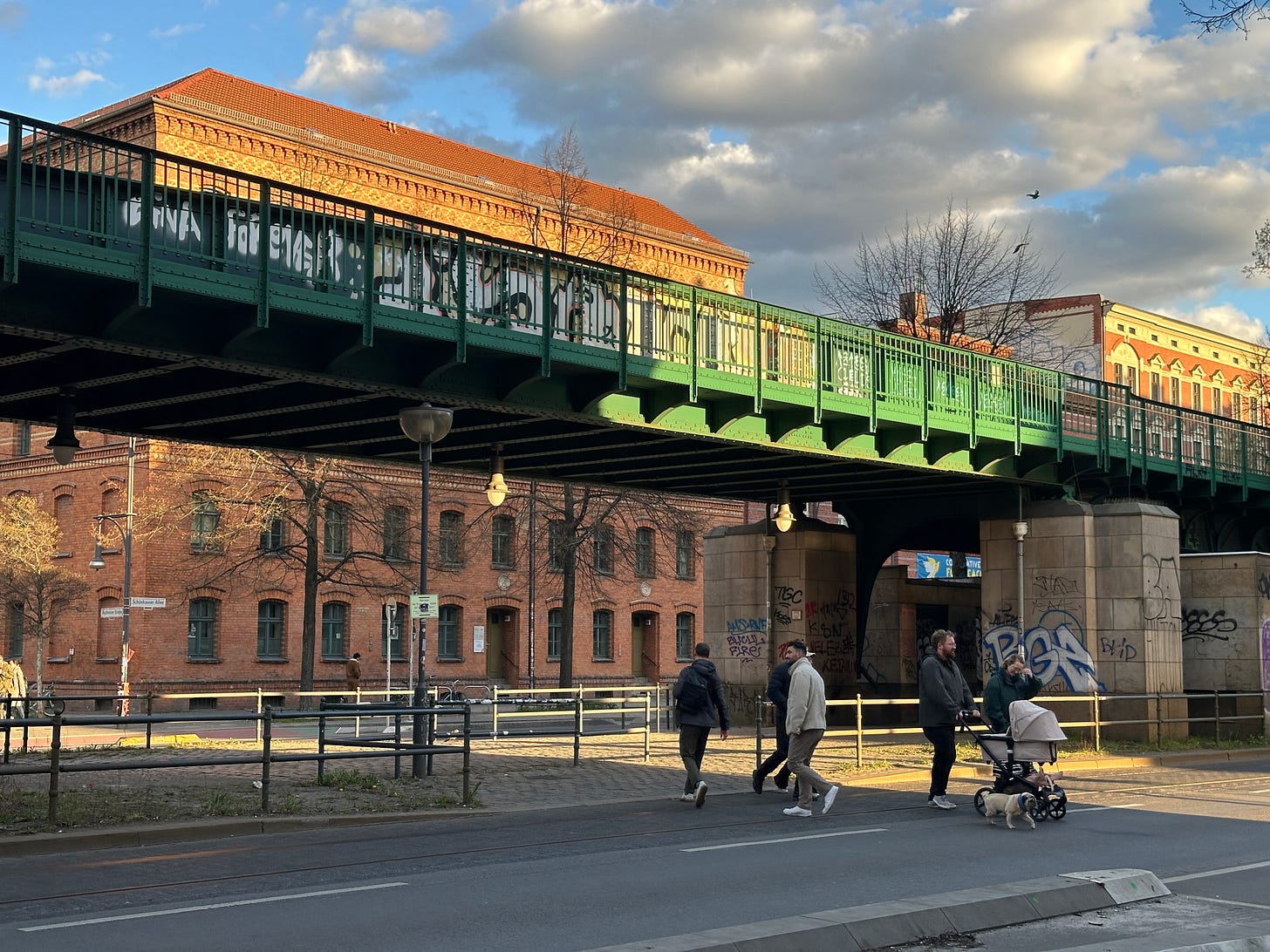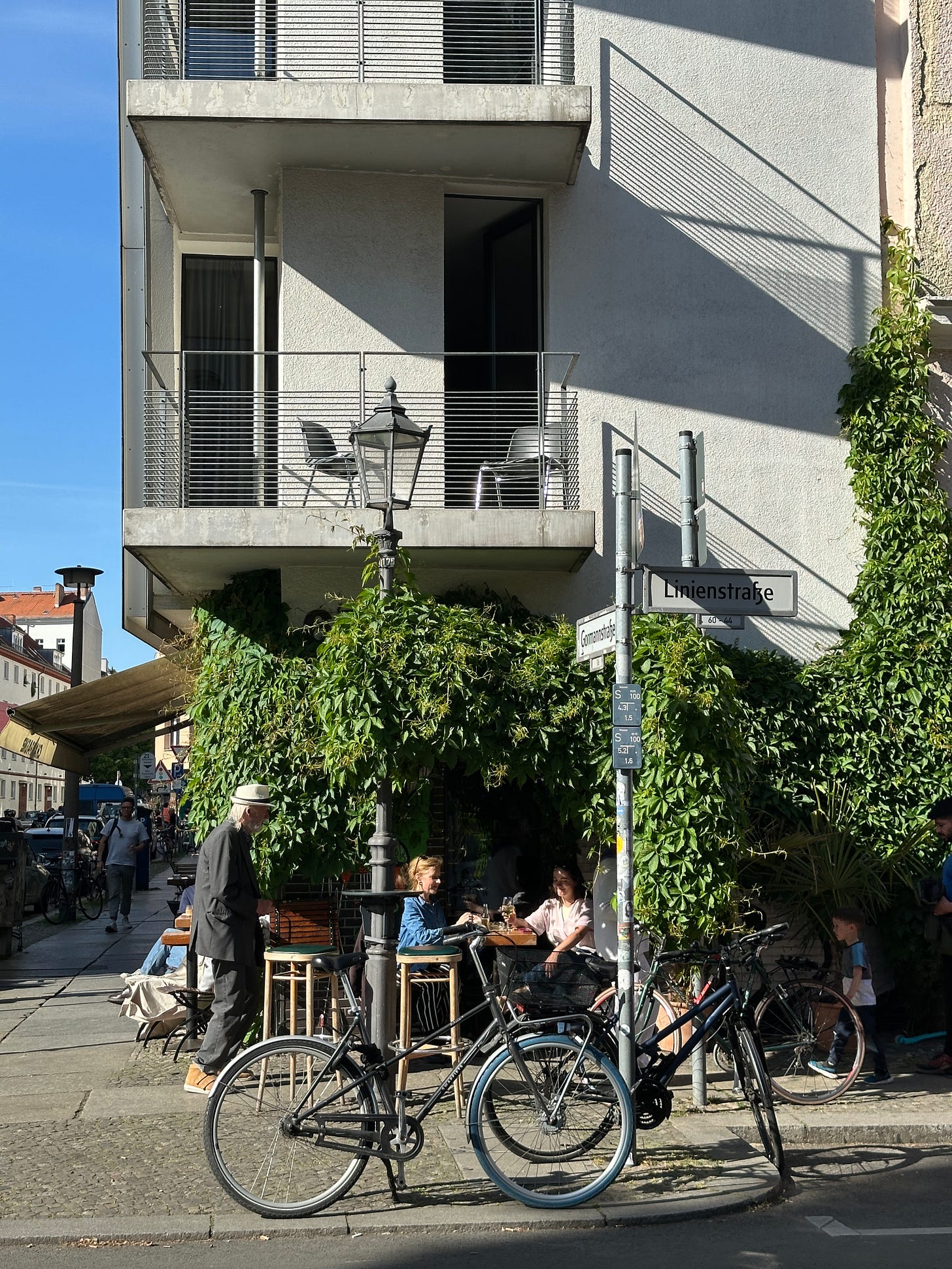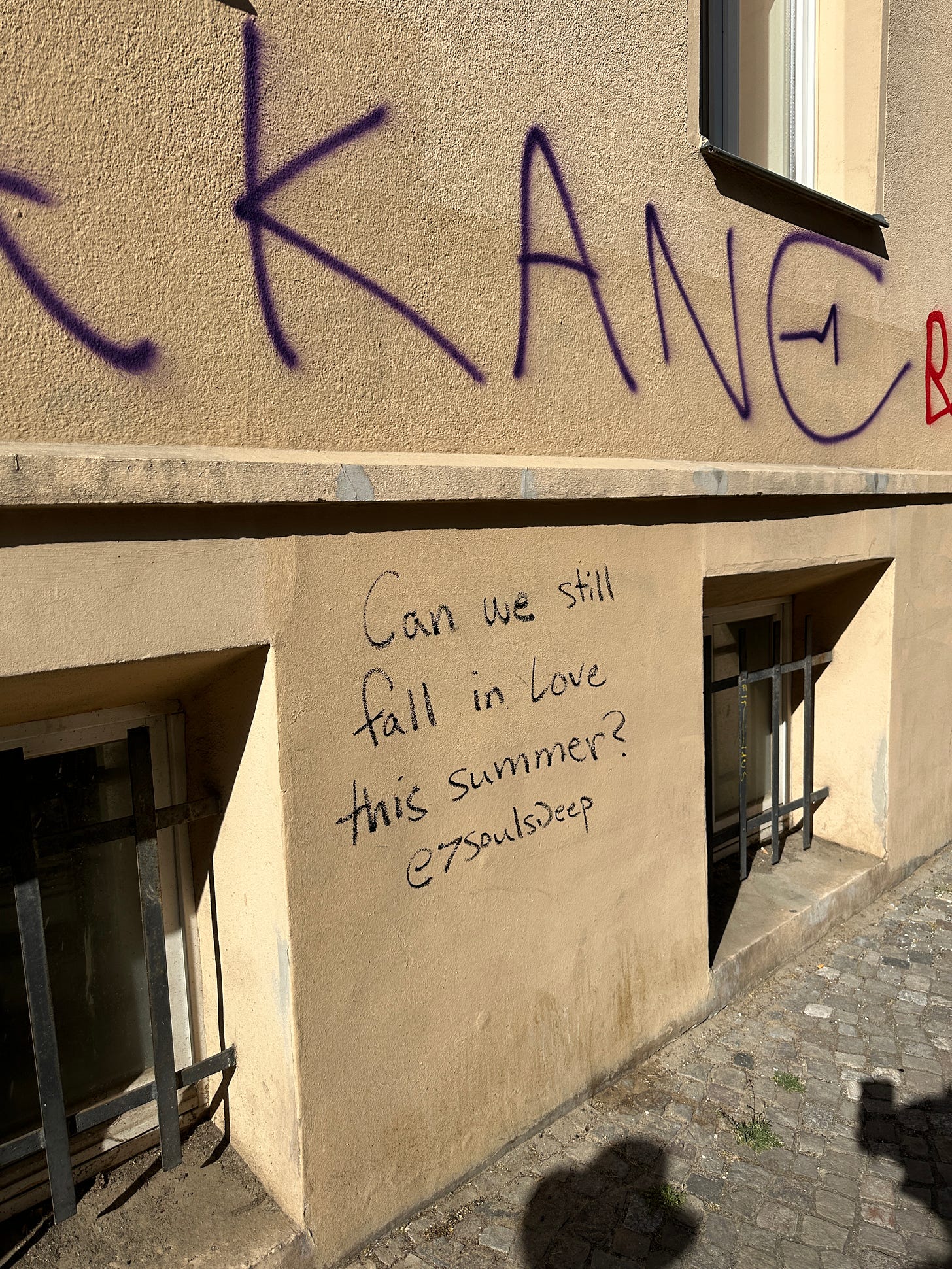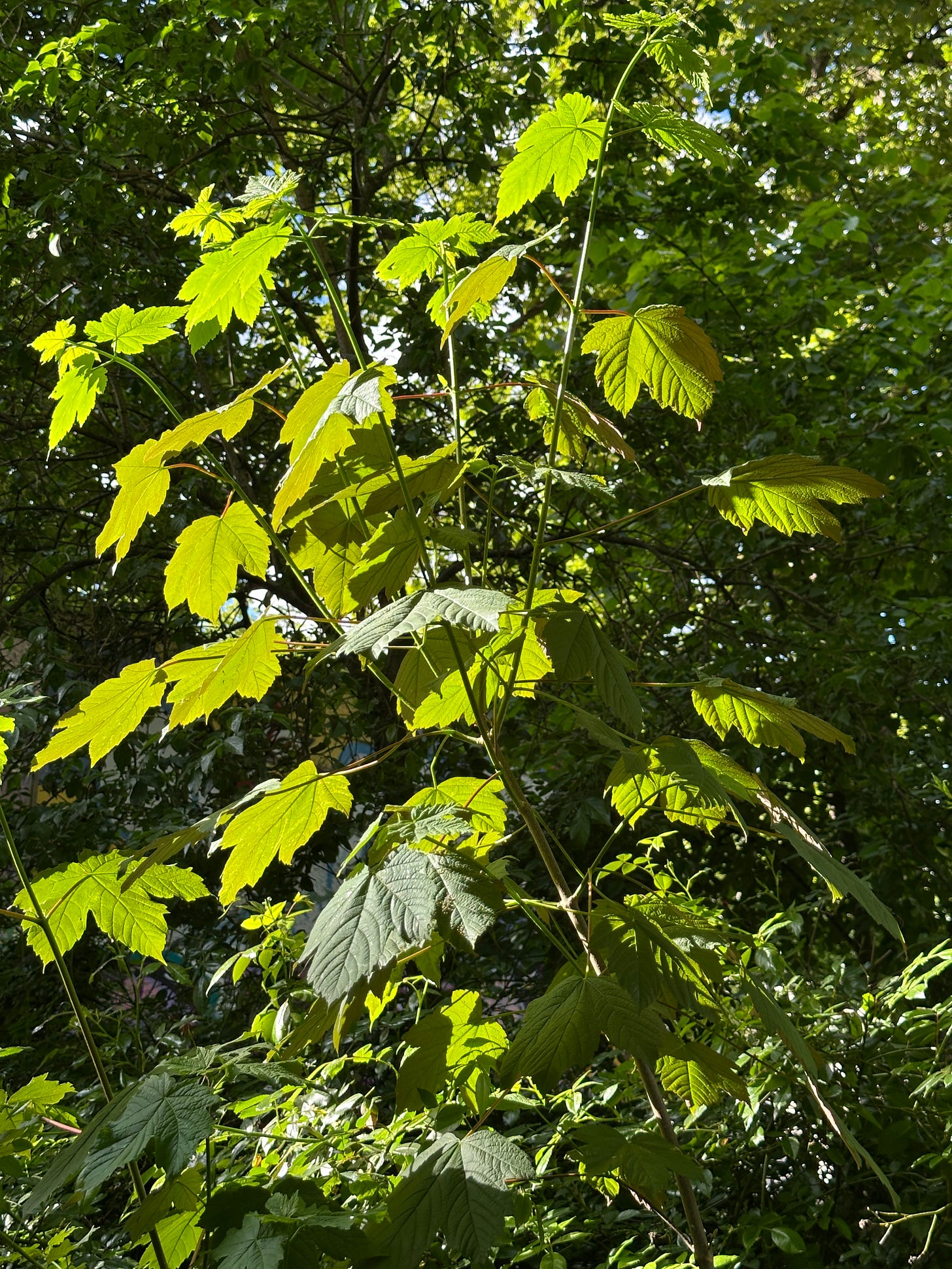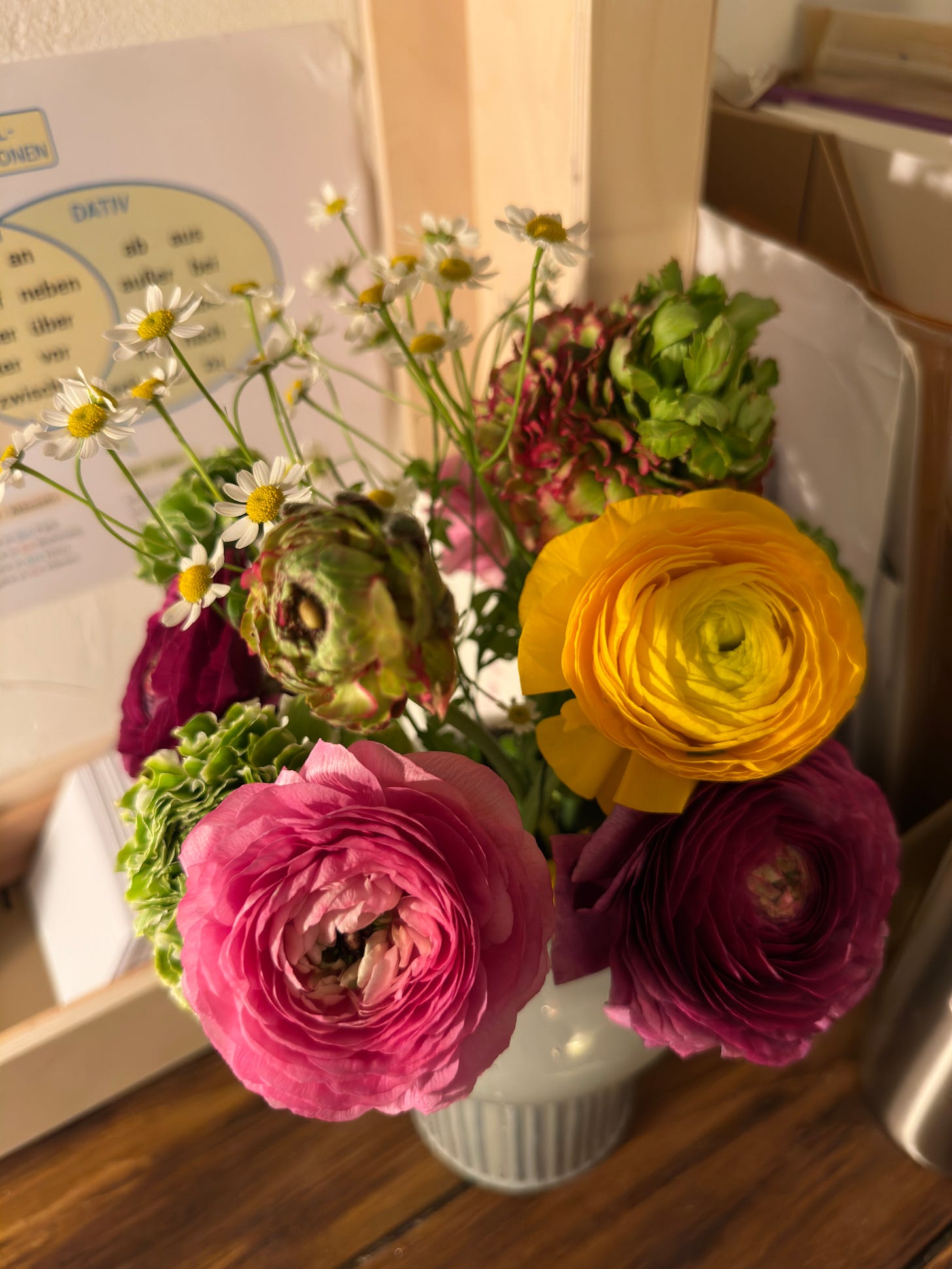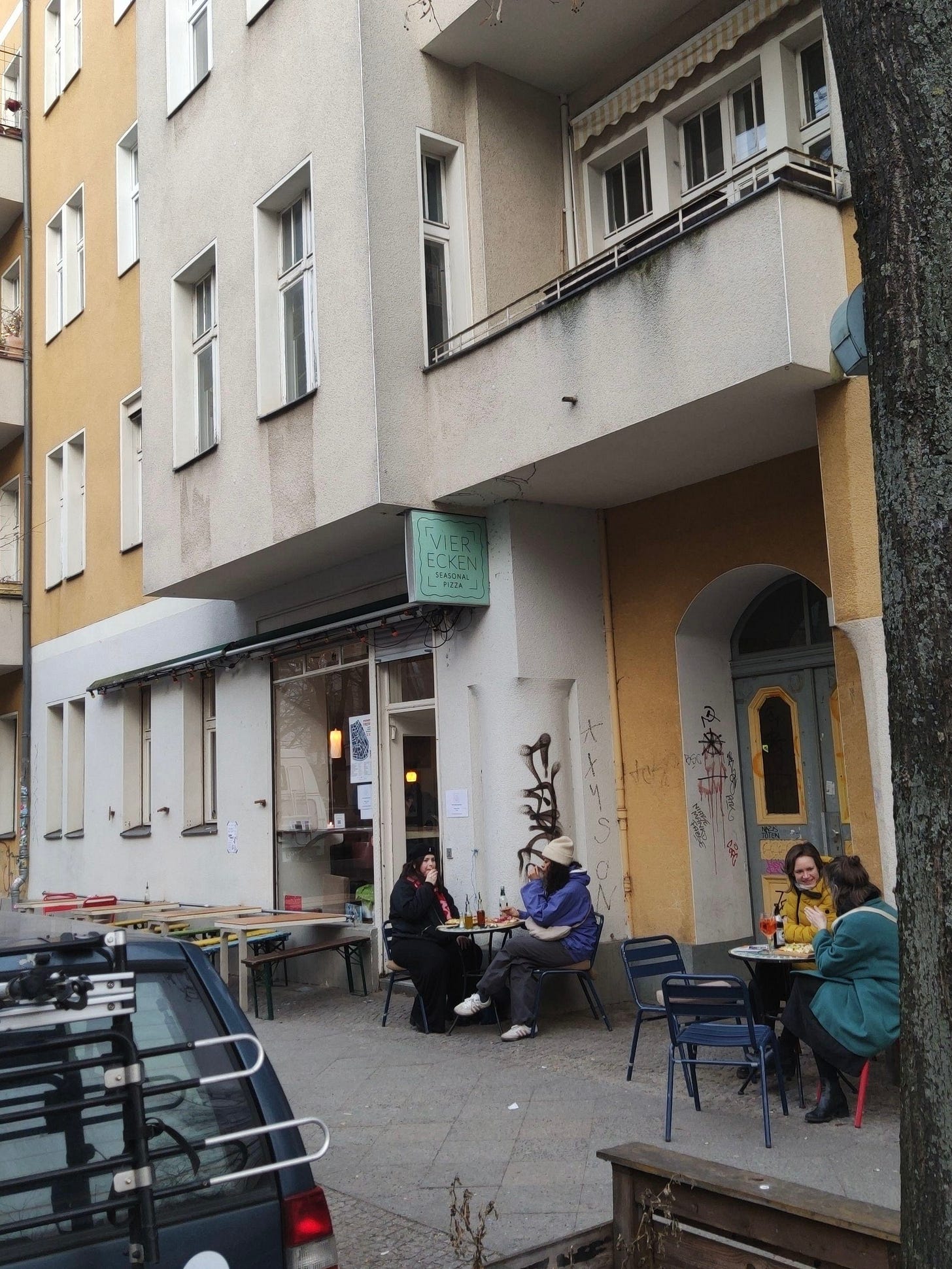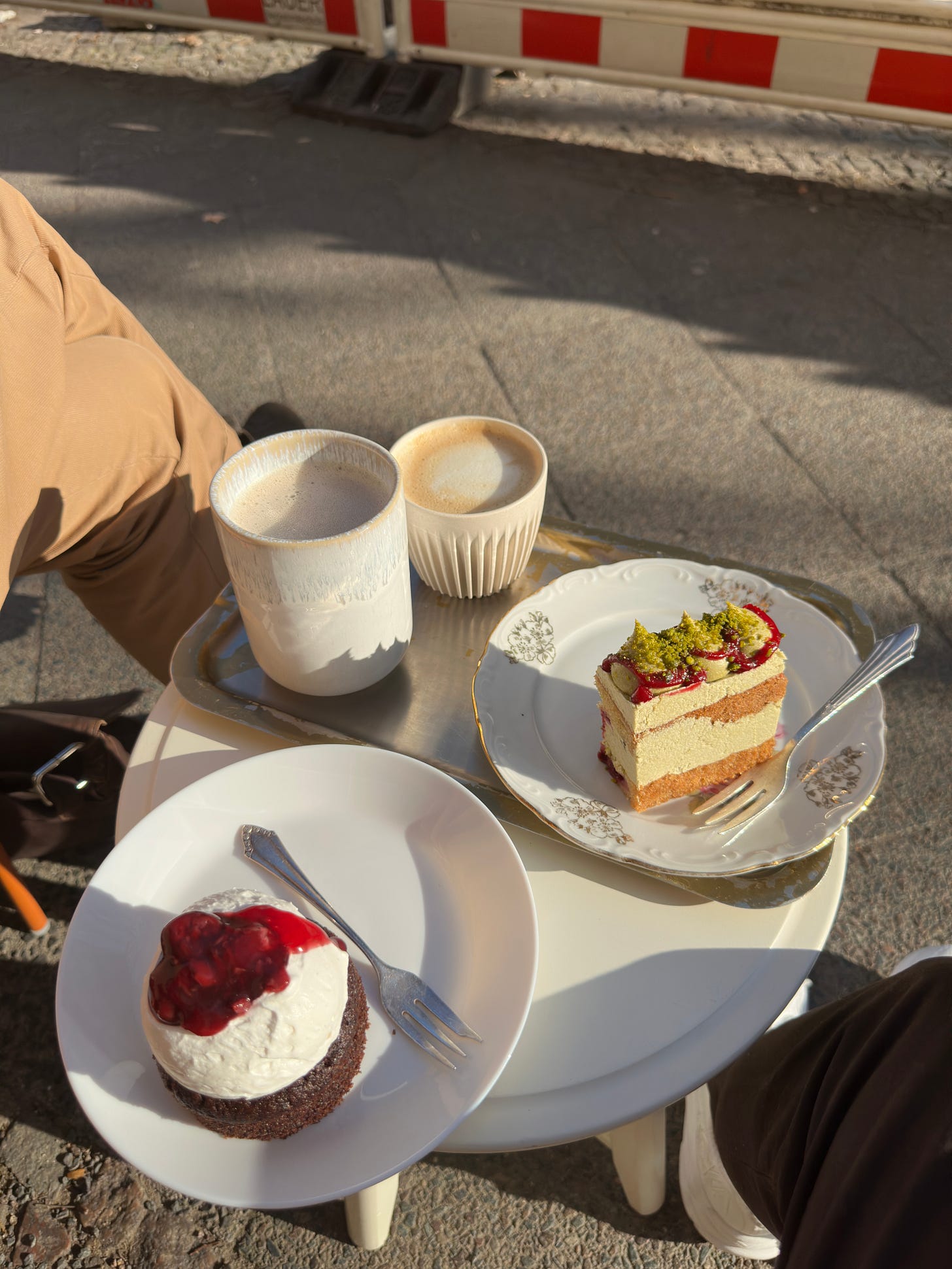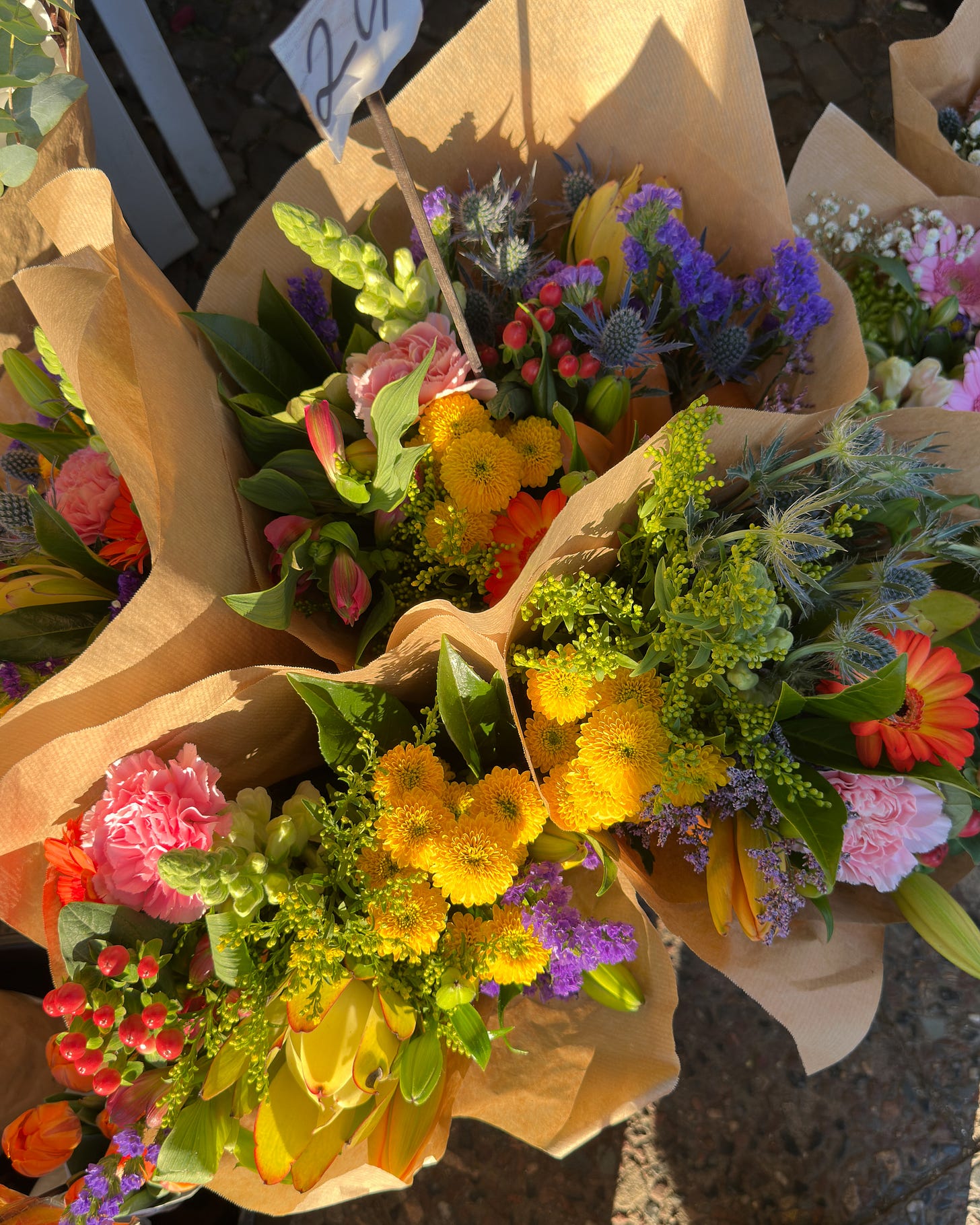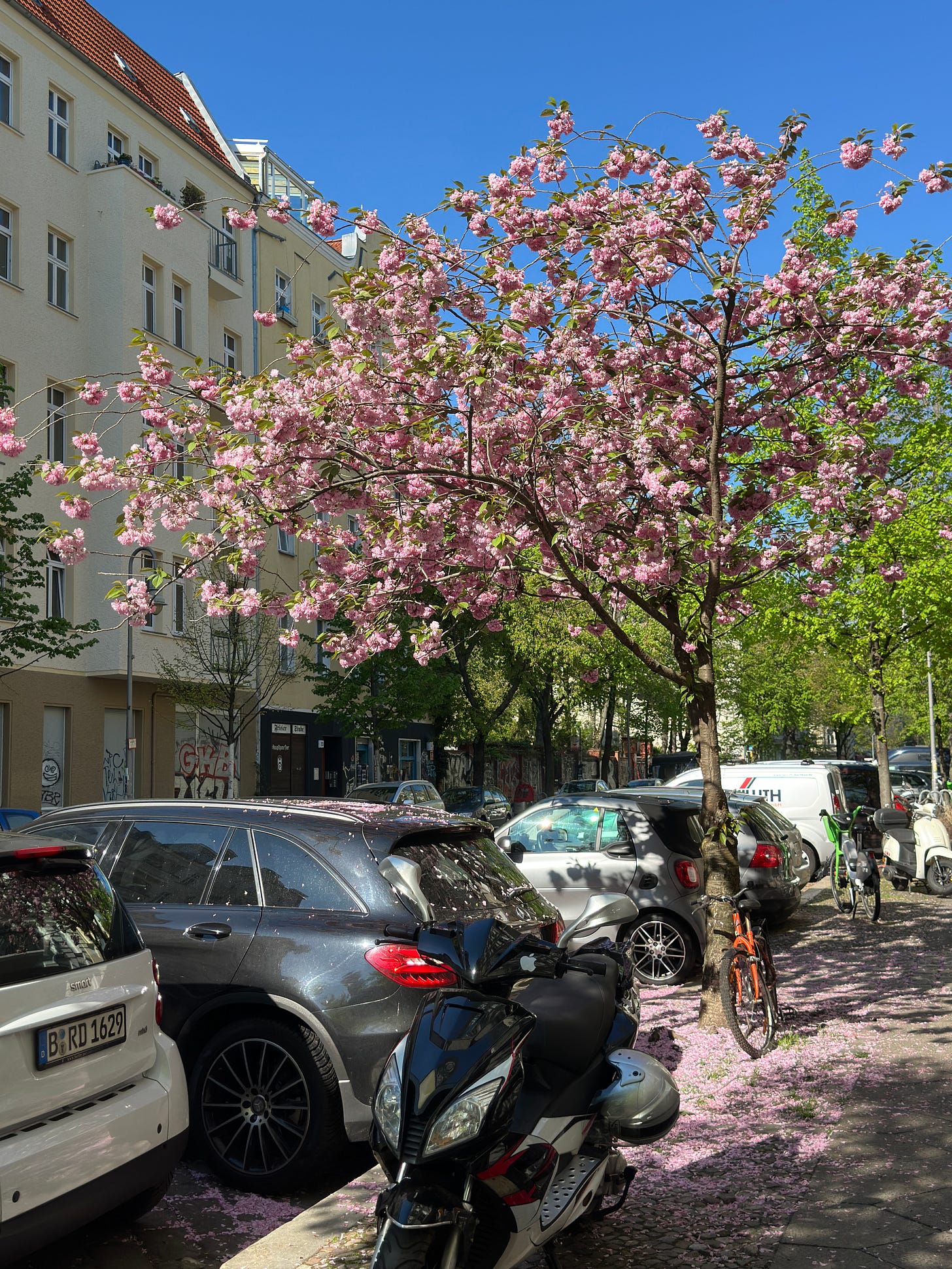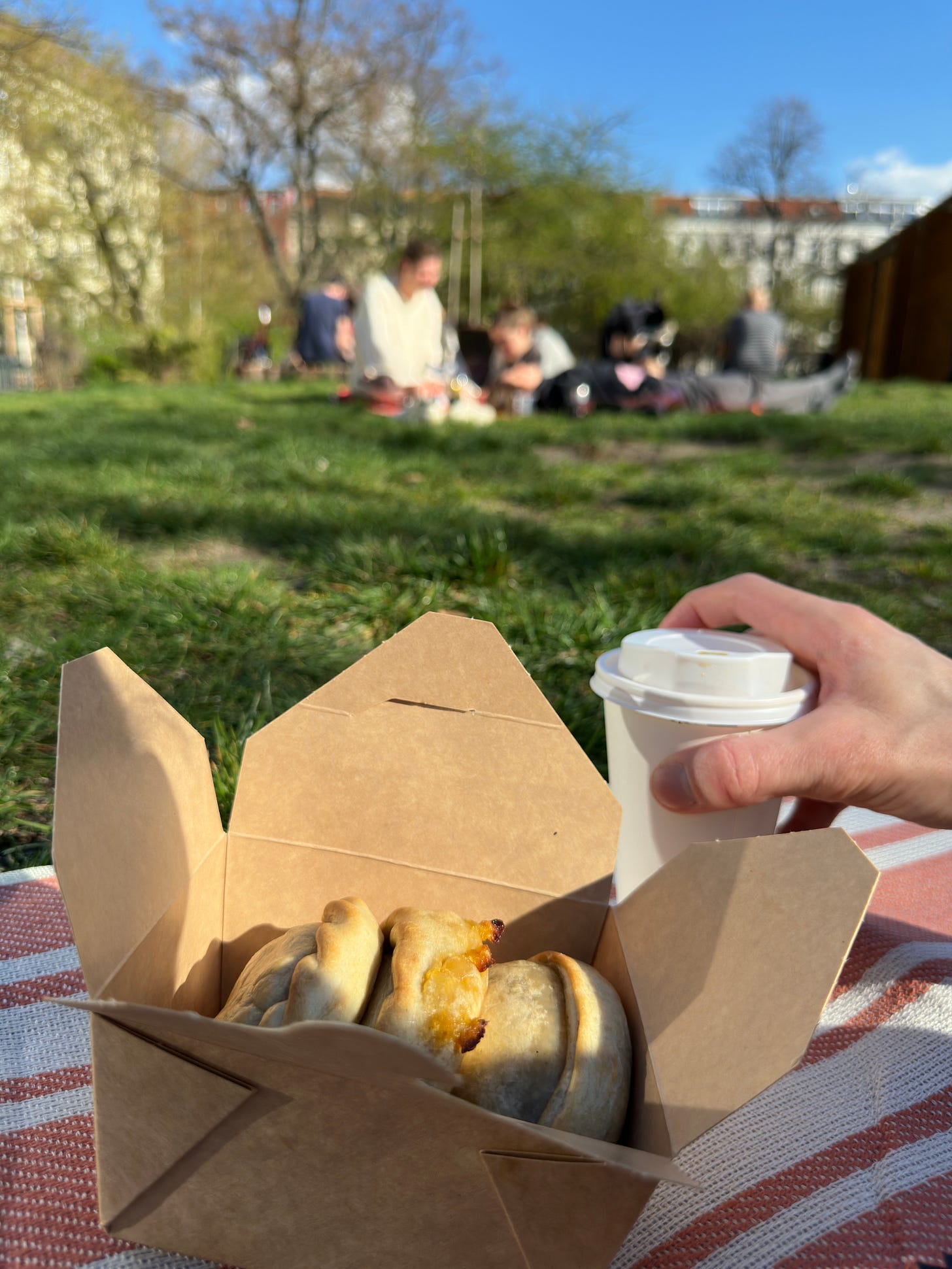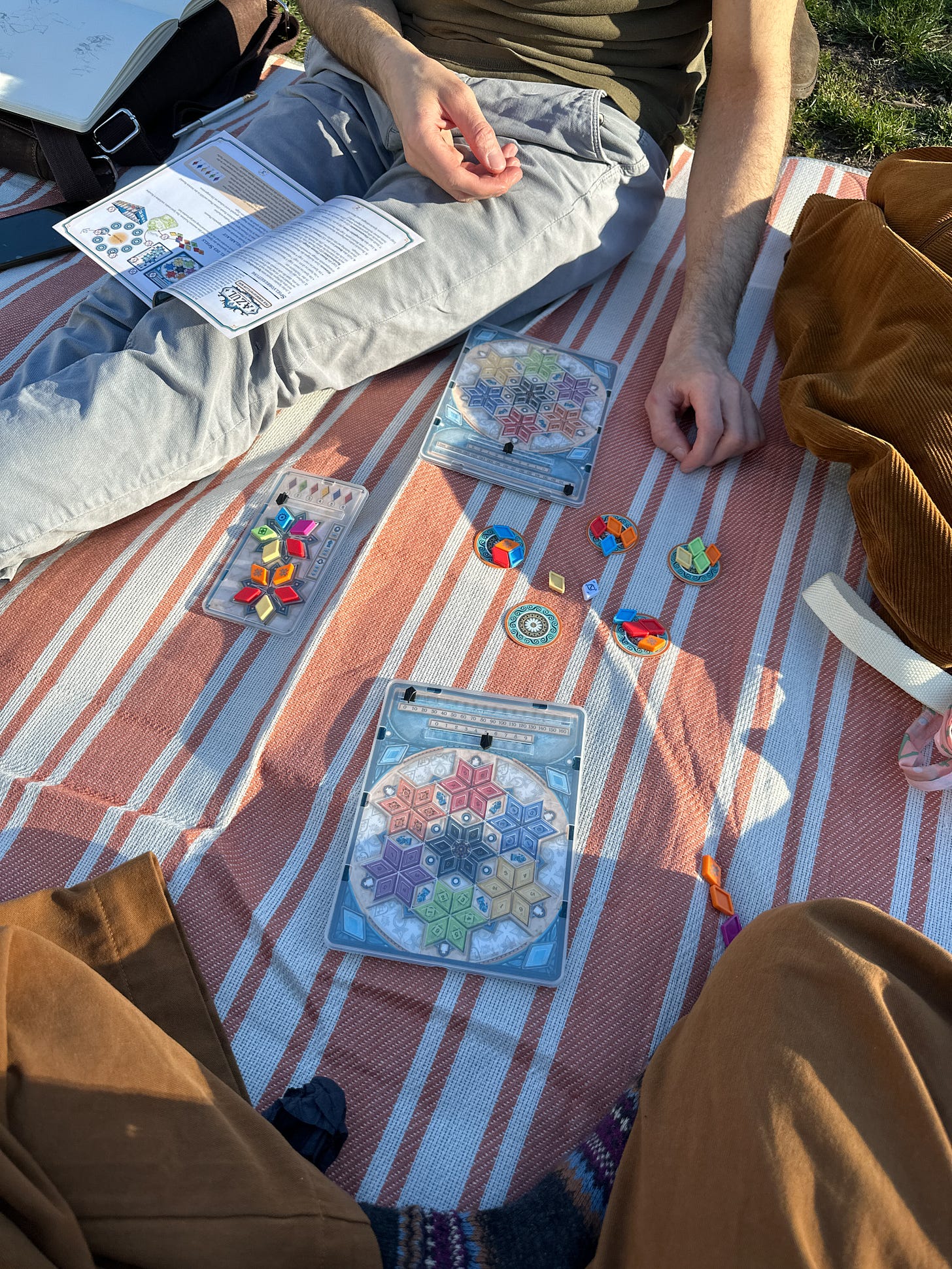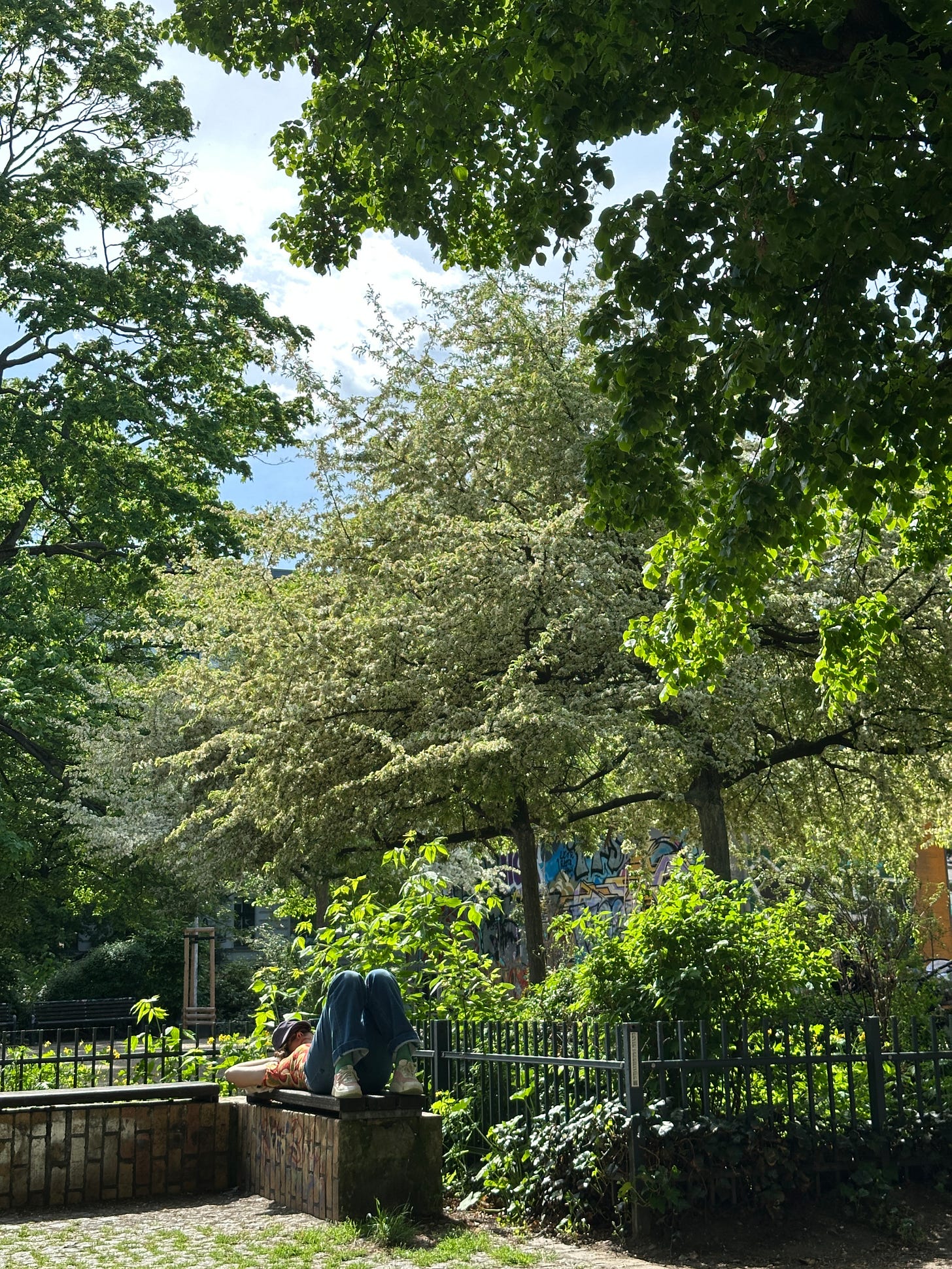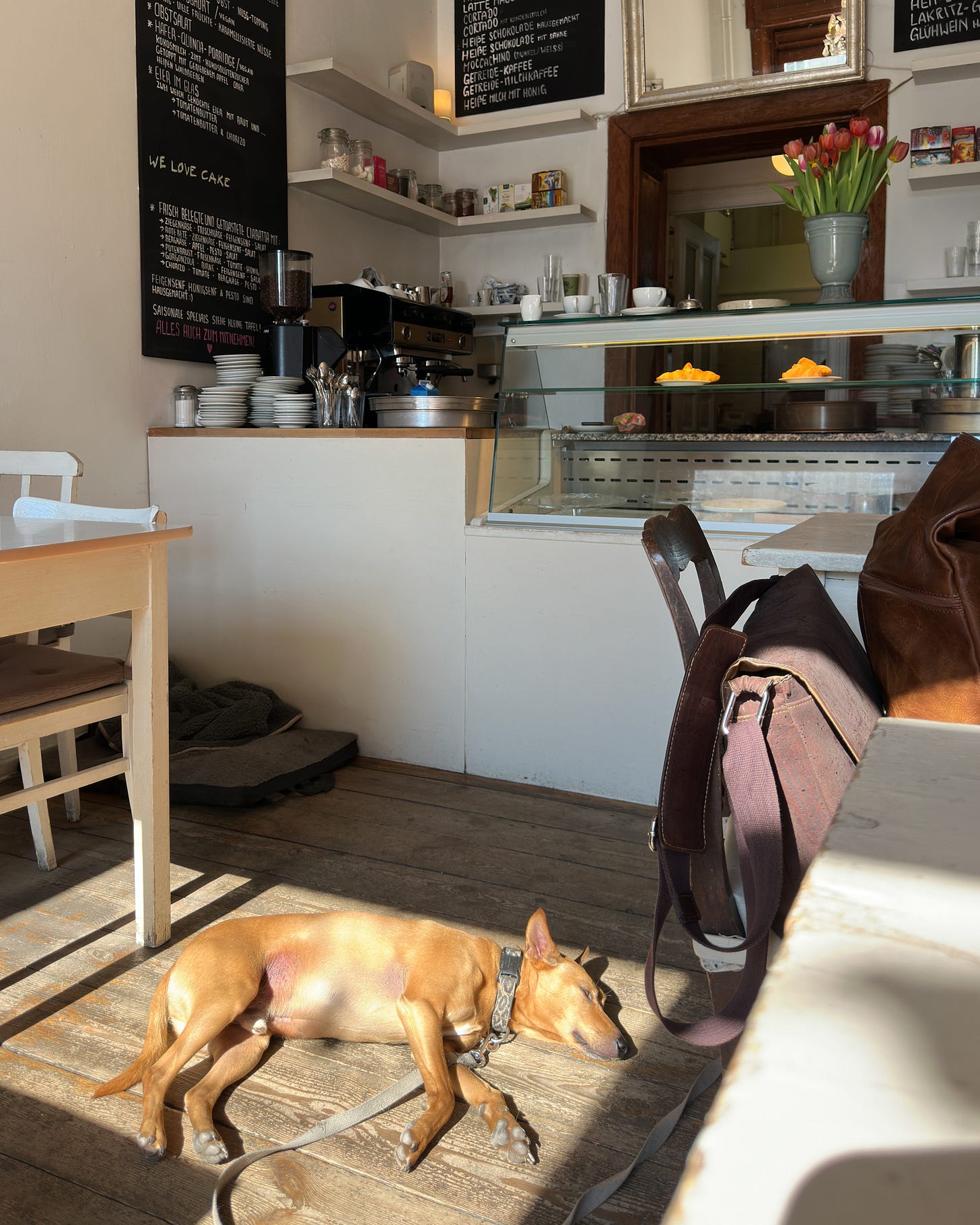Finding my legs again
Turnings & transitions, Feb–May, 2025. Dispatched from a cafe in Berlin.
However you found your way here, welcome! I’m Emily, and I write letters about how we seek and tell stories to make sense of a changing world and our place in it.
I arrived back in Berlin in late February, when sidewalks and street corners were still covered in snowfall from a few days’ prior. The weather was slightly warmer, sunnier, than I had expected. I hadn’t been back for more than a year, and I was curious to be here at the tail end of winter, since we usually visit W.C.’s country in the thick of the winter season, in time for Christmas. We returned to our building with its dilapidated facade, patchy where plaster had torn off, scrawled with graffiti, bricks chipped off windowsills. It was already dark when the taxi dropped us off, and entering the inner courtyard all I saw looking up were rectangles of yellow light, alternately sickly and warm. The building could look grim on the outside, but we had made our apartment cosy. I was greeted with note cards W.C. had strung up spelling out WELCOME HOME ! above a tall bouquet of red and yellow flowers stuck in a vase. (He’d come back a few months ahead of me.) I unpacked while W.C. cooked us a mushroom-and-veggie stew—it was too late to dine out—and I showed W.C. what I had brought back with me from Malaysia to stave off the occasional pangs for home: packaged Mushroom Lah rendang and dried lion’s mane mushrooms, as well as my mum’s jar of garlicky red chilli paste, rolled up in kitchen tissues and a plastic bag, bound tight with thick rubber bands.
The next day, in the wan light of this in-between season, I saw that management—though that sounds much too corporate for our building, perhaps the Hausmeister?—had removed the vines that once snaked several floors up the walls of the inner courtyard, which I had come to regard as its most defining and charming feature, by which I could always observe how one season began to turn into another: from bare skeletons to trails of green leaves, then red leaves, then yellow leaves, then back to bare skeletons again. In their place now, there’s an absence: deep, thin bare lines like tributaries of a dried-up riverbed and more cracked plaster where they had been ripped out. Later, we realised that this was probably a prelude to the work now being done to the building’s facade—long overdue, one might think; but also, will this soon mean a letter sliding into our mailboxes, announcing higher rents? My cousin, when she visited us recently, joked that our apartment building looked “Berlin AF”. Turns out it might not be for much longer, once the facade is levelled and and cleaned up and painted over—like the adjoining apartment building right next door, which, for the longest time, stood as a stark contrast to ours. Right now, the inner courtyard of our building is mapped right across with scaffolding, parts of the walls—together with the graffiti and the children’s chalked drawings of humans and animals—already scraped down to their the peach-coloured brick foundations. Whenever we step out into the courtyard we must first look up, or one of the workers will see us and yell up at his colleague to STOP! In our residents’ WhatsApp group, someone had already warned us all to be careful, that they had already been hit by a rock—luckily, no real damage—as the workers work their way down the walls. Every day, as I hasten out, I dodge past the rubble and debris and hold my breath against the dust.
I had returned to Berlin in a orthopedic boot, or what I liked to call my ‘Roboboot’, with crutches for extra support. Two days after Christmas I had fallen down the stairs in my parents’ house—yes, clumsy me!—and broken the fifth metatarsal bone in my right foot. Though I was managing quite well getting around, it was a different proposition with luggage or walking long distances with luggage, since I would need my hands for my crutches or at least have them free to better balance myself, so I requested wheelchair assistance from the airline —which meant I was fast-tracked through all the usual stops: it was the smoothest airport experience I’ve ever had! I hadn’t realised that the service is, rightly, free: you can request wheelchair assistance right up to your plane seat (they may use a portable lift to take you up), or simply to the foot of the boarding steps. I didn’t have to submit any formal documents, though I had requested a letter from my doctor just in case. On the day of my flight, an airline/airport employee pushing a wheelchair met me at the check-in counter. I could also have my boot and crutches with me on the flight without additional payment for weight: they didn’t factor into my hand-carry allowance.
Some sixteen hours later I landed in Berlin and was immediately greeted by an airline employee with a wheelchair and then transferred to an airport employee with a wheelchair. It had been the same during my layover: I suppose, airports being such sprawling spaces, it’s more efficient for staff to stay in their respective orbits, that you get passed along, mostly efficiently, via wheelchair or buggy, in a chain of service while they communicate over their walkie-talkies. Having taken the train in, W.C. was at arrivals to meet me, beaming after our four months apart, taking over my luggage while I walked myself on my boot and crutches to the taxi stand outside. With W.C., it’s become a ritual for us to see each other to the airport or to pick each other up, whether in Kuala Lumpur or Berlin, even if it might be more convenient to say our goodbyes or hellos at the nearest train station in the city. This was one of the things I liked about him when we first got to know each other, something that seemed a piece with the rest of his way towards people, strangers or friends: a certain old-world courtliness. A long time ago, when we were still just friends, he mentioned that he had thought to take the train to pick me up from the airport on my second visit to Berlin: this was after I had already arrived and we were meeting at a cafe in the city. I believe I said, over coffee, Ah, of course not, don’t be silly! It’s not necessary. Why trouble yourself when we could just meet in the city? But secretly, I liked that he thought of it. Later, when we were no longer just friends, he confessed that he had only decided not to offer it at the time because he thought I might be the sort of person who might think the gesture ‘too much’. How many things do we refrain from doing for others, platonically or not, because we think it might be ‘too much’? Love, affection, or mere consideration: in our present world, it’s never too much.
I love walking the city again, being able to walk the city again. I think it’s probably my favourite thing about being back here. Berlin is a lot easier to navigate on foot and has more extensive public transport links than Kuala Lumpur, which is mainly built for cars. Yet, I was still healing from my broken foot, so I had to ease slowly back into it. In the first couple of weeks, I walked around on my boot around our neighbourhood, relied on Uber for less manageable distances. Some days, though, there was no choice but to rely on Uber and its alternatives, since there were several strikes by BVG staff demanding better wages, which they got.
By mid-March, I began to wean myself off my Roboboot. I first had to look for a pair of sneakers that would feel comfortable—none of my old ones fit; they were too tight as my healing foot was still slightly swollen. I went to a sport-shoes store and tried on what felt like the entire women’s range of shoes available, and finally found one that felt comfortable: thick cushioning, relatively flat, with a heel drop of just 5mm. I had to go up a whole size and a half to accommodate my swollen foot, which meant it was a little roomier on my good foot, which meant I had to wear an extra pair of socks on it. I went around like this, my feet slightly mismatched for a while with a kind of secret glee. At the same time, I felt exposed without the hard shell of my boot and I was always careful to hold my bad foot close to my body at zebra crossings or on public transport for fear that someone would step onto my toe and undo whatever delicate progress had been made.
But it’s been a ritual pleasure to walk again—particularly in our neighbourhood, in former East Berlin. Carlos Moreno’s concept of the ‘15-minute city’, which imagines residents living within a 15-minute walk or cycle/train/tram/bus ride away from all the services they need—work is still likely to require travelling further for most—feels right at home here. Everything we need (and want) we can find in our vicinity: grocery stores, cafes, restaurants, bars, small parks, bookshops, tailors, hairdressers, print shops, stationery shops, outdoor gear shops, clothing boutiques, utility shops, flower shops, post offices, DHL/Hermes Paketshops, doctors, dentists, fitness centres, physiotherapists, board-game, jigsaw-puzzle and comic-book shops, even a Chinese foot-reflexology parlour! Anything else is an easy ride away, since we have U-Bahn and S-Bahn stations nearby, as well as several tram and bus lines criss-crossing our neighbourhood.
With a subscription Deutschland Ticket for 58 EUR per month, we can avail ourselves of all public and regional transport throughout Germany (not always practical depending where you want to go, but still)—excepting intercity (IC and ICExpress) trains. So it’s a matter of just hopping on and hopping off, which makes the whole experience of navigating the city feel quite seamless, like you’re moving through it on a kind of horizontal elevator—or, less romantically, a conveyor belt (excepting, also, delays and disruptions and peak times). BVG, Berlin’s public transport authority, itself also offers a subscription city-wide travel card, but it’s almost double the price of the Deutschland Ticket (federally administered by Deutsche Bahn) and doesn’t allow you to use public transport in other German cities.
All of which is to say: this makes walking and taking public transport here very easy. I just have to remind myself to always have my phone on me and to make sure it’s not dying so I can flash my digital pass on the DB app if I’m checked by the occasional plain-clothed officer—usually outfitted in a tracksuit, it feels like?—making their rounds. Unlike in other cities, there are no turnstiles regulating entry at train stations in Berlin and you don’t need to tap in and off when you get on a tram or bus. I know people take advantage of that; I don’t, simply because I have no stomach for stressing about whether I’ll be spot-checked—I like to leave my mind to just wander while on a train or a bus or a tram—and also because I think if you’re enjoying the utility of a service and you can afford to, pay for it.
Not long after returning to Berlin, I went to our local Bürgeramt and got myself formally registered to an address, proof of which is a requirement for various administrative setups in Germany: bank account, mobile plan, health insurance, etc. I’ve also started to deliver online purchases or have family and friends send me things in my own name rather than in the ‘c/o’ W.C. because in Germany—or at least in Berlin?—door bells and apartments are not affixed with numbers, but surnames. This system struck me as strange and nonsensical at first: I wondered about all the letters and packages that might fall through the cracks between tenancies, though I suppose tenancies here tend to last longer than in other cities—reportedly, about 85 percent of Berliners are tenants. It also felt a lot less private to me to have one’s name on the door; I’ve always felt more comfortable in cities that encourage anonymity: the kind that allows more intimacy. But I’ve slowly come around to this naming system. I also appreciate how couriers will leave your package with one of your neighbours if you’re not home: you’ll get a card in your mailbox telling you which neighbour—you’re given their surname—to pick it up from. Soon, you remember that so-and-so with the curly-haired kid lives on the second floor, that so-and-so who plays the piano is on the fourth. And I don’t remember anymore which neighbour it was who started the residents’ WhatsApp group, but it’s been useful: when we’re missing a package and the courier evidently forgot to slip us a notification, when we needed to borrow a drill to put up wall shelves, when we had too much leftover cake from a party to finish ourselves. Bring your plates to our door, we said. We’ll fill it up!
Our flat is located in the Hinterhaus of our apartment block, on the ground floor, where we don’t get too much daylight for too long. In the summer months, this also makes it colder indoors than it actually is outside, and whenever I pull aside the curtains and look up at the sun spreading its rays high up in the blue sky, I’ll feel the urge to step outside—which, great, what’s not to love being outside? Except: I still sometimes work best at my home desk, which is surely more spacious than any cafe’s table, and where I can spread out my books and notepads and reference materials alongside my laptop. (Besides, many cafes here impose a no-laptop policy, particularly on weekends—which, for the most part, I understand, though it seems counter-productive when the cafe isn’t full and it’s an hour to closing time.)
Still, the loveliness outside can make one feel restless indoors, and being in this city, I realise: all I actually need, much of the time, is just a jaunt around the neighbourhood. I don’t necessarily need to stop in somewhere for coffee and linger on, I’m happy just to walk for a bit in the—don’t tell me it’s not!—fresh-seeming air, feel the sun’s warmth on my face, sit on a park bench and read a book chapter or two, pop into a bookshop or florist’s to pick up a new title or a bunch of buttercups, matthiolas, peonies (now in season), chamomiles, or billy balls, and return home. Which reminds me of what a writer friend told me when she moved back to Kuala Lumpur from London last year: that after so long going without, she now needed a gym membership because she couldn’t walk the streets as easily or extensively anymore. Similarly, now that I’ve found my feet again and settled into a smoother gait, I’m walking some 30-40 minutes again every day and cancelled my Classpass membership, which I relied on in Kuala Lumpur. I still need weight-training, but I’m waiting till I can flex my bad foot better to get back to yoga or pilates.
The blankets, and then patches, of snow I returned to in late February lingered on the streets for a few days before melting into grey slush and evaporating. It was something like 10 to 12°C those first few days, before creeping up a fortnight later to 16 or 18°C. You could still see dogs shivering beside their owners at tram stops, even if they were also bundled in jackets. But even then, as long as the sun made some kind of appearance, there were already people braving the cold, sitting on chairs and tables optimistically arranged outside. Berliners, it seems, will jump on the slightest excuse to sit outside, or on windowsills, even when it means facing a dug-up street bounded with white-orange striped construction plastic barriers. Then, came March: the trees still mostly bare, their branches brittle, stretching ineffectually for succour. Against this, the red of a neighbourhood church, or the orange of an old brewery, when touched by the sun, was a vibrant splash of colour. A baker, taking a custom cake order from us, told us that she couldn’t decorate our cake with fresh raspberries or blueberries as she makes it a point only to use fresh fruits when they are in season locally, so would a frozen compote do? In mid-March, heralding the coming of spring, a vegan Japanese cafe began serving matchaand-fresh strawberry shortcakes and we went to try it. Everything has its season, as I’m trying to remember.
On April 4—I remember the date exactly—the temperature edged past 20°C for the first time and we bounded to our neighbourhood park with a picnic blanket. While I guarded our things, W.C. went to buy some corn empanadas and coffee from a nearby cafe. We read, sketched, snoozed, played Azul Summer Pavilion. Everyone—families, young people, children—co-existed with the small group of homeless (I think?) who had set up camp against a line of bushes. Once, we saw a man leave the group, yelling, “I would rather sleep once with somebody who really wanted me than be f**cked a thousand times!”—or something along those lines; it was uttered in German, W.C. translated—before hurrying away, fidgety and disgruntled. Another day, we wandered into the grounds of one of the red-bricked churches I mentioned, sat atop one of its surrounding walls, and ate our leftover party cake from a tupperware, soaking in some Vitamin D. In the days after, the temperature dipped back down to 16-19°C, 12–13°C. The weather was unpredictable: from one day to the next, it could be 10°C warmer or colder.
Still, the days were visibly stretching, the sky brighter. It was in April too that I began to see pink and white cherry blossoms emerging here and there on the sidewalks, tentatively at first, then seemingly all at once, riotously—growing into downy proportions, like low-hanging clouds. A restaurant hung up a banner over its entrance announcing that it’s Spargelzeit! and rhubarb crumble began making an appearance on menus. Then, again: the temperature, for a very short spell, climbed up to 23°C, hot enough for me to pat on sunblock and wear a sunhat, occasionally slip on sunglasses I got a long time ago, the reflective lenses striking a vaguely obnoxious pose which I feel self-conscious about. We began to see dogs sunbathing, their humans sunbathing.
Today, it’s 13°C again and it’s been raining all day.
E.




